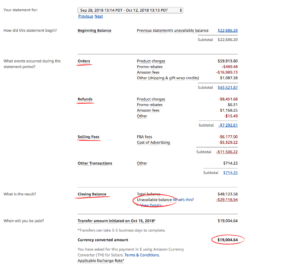Amazon is a juggernaut, a titan of the tech era and one of the most successful businesses in history. The world wants in on Amazon, from self-published first-time authors to well-established companies and manufacturers – and it is all to Amazon’s benefit, because as you make money, Amazon takes money several times over. You may think you’ve figured out everything there is to know about Amazon, but few are fully aware of just how much Amazon takes. At Knoza, our business isn’t with Amazon, it’s about Amazon, and we want to enlighten you about the true cost of operating on that site.
Amazon’s costs come in many shapes and guises, and it’s important to remember that Amazon gets paid first. For example, most Knoza clients have a Professional Selling Plan with Amazon. While this certainly has its benefits, including no per-item fee, the subscription plan still costs $39.99/month. It is also common to sell products Fulfilled by Amazon (FBA), in which your products are shipped to an Amazon warehouse, and then they deal with distributing your products to paying customers. This fulfillment fee, even for products weighing under one pound, is still more than $3/unit. For nine months out of the year, Amazon’s storage fee for normal-sized items is 69 cents/cubic foot/month; for the other three months that fee more than triples. And every time you sell a unit, Amazon charges you a referral fee, usually at 15%. Sometimes this fee is lower, and it may be beneficial at times to change a product’s category in order to get a lower referral fee, however Amazon is known to charge return fees for products under categories like Clothing and Accessories.
After this long list of fees, Amazon further recommends implementing ads. The value of these ads to your profit margins can be measured by the ACOS – the Advertising Cost of Sales. In short, the lower the ACOS, the better. For example, if a product sells for $10 and has an ACOS of 20%, that means it cost you $2 in advertising to get that product sold. This ACOS combined with the above fees leaves you with less than $3 left over, and that’s not even considering profit or cost of goods and manufacturing. Amazon’s fees turn a successful sale at a whopping $10 into a measly $3, and there’s little that can be done about it.
The impact of these costs and fees can be difficult to grasp on a large scale. Below, you can see a real-life example of a client’s revenue and costs over a 14-day period:

In so many fields, customers can negotiate better situations for themselves. Established patrons can get a discount at their favorite restaurant, warehouses can reward loyalty by reducing fees for long-term manufacturing partners, and other institutions can employ certain initiatives for retaining longstanding customers. Amazon is not one such institution. These fees are non-negotiable; in the vast algorithm of what turns a profit, the various fees Amazon charges are invariably fixed. There is no haggling to be done, no points to gain, no loyalty rewards to claim – and again, Amazon gets paid first. Selling through Amazon requires playing by Amazon’s rules. There are three things to remember when dealing with Amazon:
At Knoza, we’ve done our homework. There’s no finagling or haggling to get fees dismissed, but because our sole focus is dealing with Amazon’s inner workings, we strive to put your products in categories where some fees can be reduced whenever possible. No one can fix the problems of refunds, but you can see here how Knoza’s unique Revenue Recovery Program softens the blow by providing you with what is essentially free money at no risk to you.
The market Amazon has created is new, revolutionary, and provides untold prospects for untold sellers. At Knoza we work tirelessly, traversing the mire of Amazon’s ever-changing rules and regulations to minimize your costs where possible and maximize your revenue through search engine optimization including Enhanced Brand Content and ads. Working with Amazon involves costs, fees, and missed opportunities that individual sellers simply can’t keep track of. Knoza can help you make the most out of your Amazon experience, but the single most important thing to be aware of when selling through Amazon is this: know your costs. Fully understanding the various charges and fees provides you with a better picture for what to do when dealing with Amazon. Navigating through Amazon isn’t easy, but it has been done, and it’s a feat that can be accomplished as long as you’re aware of the costs along every step of the journey. Amazon gets paid first, but don’t let that stop you. Know the costs, and let every decision you make about the site be the right one.